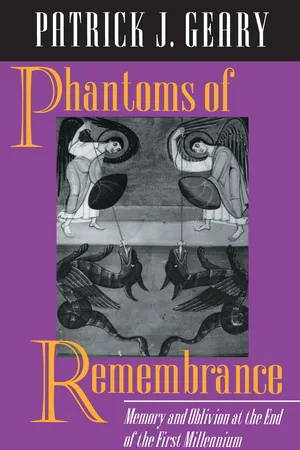![]()
NOTES
ACKNOWLEDGMENTS
1. Friedrich-Wilhelm Westerhoff, Gruppensuche. Ein Verfuhren zur Identifizierung von Personengruppen in mittelalterlichen Namen-Quellen. Beschreibung des Verfahrens und der Programme. Rechenzentrum Universität Münster. Schriftenreihe 61 (December, 1988).
INTRODUCTION
1. Andrew Lewis, Royal Succession, 22-26.
2. Rodulfus Glaber, Historiarum libri quinque (ed. and trans. France) 164-67. See Platelle, “Le problème du scandale,” Revue belge de philologie et d’histoire 53 (1975): 1071-96; Andrew Lewis, Royal Succession, 22-26; Pfister, Études sur le règne de Robert le Pieux, 60-69.
3. Neithard Bulst, “Rodulfus Glabers Vita domni Willelmi abbutis,” 450-87, esp. 482; reprinted and translated by John France in Rodulfus Glaber, Historiarum libri quinque (ed. France), 254-99, esp. 290-91.
4. On the weakness of Rodulfus as a reliable witness for positivistic history and on the political context of condemnations of the queen, see Bautier, “L’hérésie d’Orléans,” in Actes du 95e congrès national des sociétés savantes, 63-88, esp. 66-67.
5. Pfister, Études sur le règne de Robert le Pieux, 60-69, and most recently Andrew Lewis, Royal Succession, 22.
6. See John France’s questioning in Rodulfus Glaber, Historiarum libri quinque, xxvii. France is skeptical because the context for the criticism in the sermon is the consecration of the church of St. Benigne while that in the Historiu is the entourage of Constance. However, as we shall see, the two are closely related.
7. See Bulst, Untersuchungen zu den Klosterreformen Wilhelms von Dijon (962-1013), 78-80; and Carolyn Marino-Malone, “Les fouilles de Saint-Bénigne de Dijon (1976-1978),” Bulletin monumental 138 (1980): 253-91.
8. On the family of William of Volpiano see Bulst, Untersuchungen, esp. 39 and 97.
9. Rodulfus Glaber is finally receiving the attention that his work merits. See Ortigues and Iogna-Prat, “Raoul Glaber et l’historiographie clunisienne,” Studi Medievali, 3d ser., 26 (1985): 537-72; and Iogna-Prat, “Continence et virginité dans la conception clunisienne de l’ordre du monde autour de l’an mil,” Acudémie des inscriptions et belles-lettres, comptes rendus (1985): 127-46.
10. On Fulk’s family, see Werner, “Untersuchungen zur Frühzeit des französischen Fürstentums (9.-10. Jahrhundert),” Die Welt als Geschichte 18 (1958): 256-89; 19 (1959): 146-93; and 20 (1960): 87-119 (but esp. vol. 18, 264-79); Guillot, Le Comte d’Anjou et son entourage au XIe siècle; and most recently the studies by Bachrach, “The Angevin Strategy of Castle Building in the Reign of Fulk Nerra, 987-1040,” American Historical Review 88 (1983): 533-60; “The Idea of the Angevin Empire,” Albion 10 (1978): 293-99; “A Study in Feudal Politics,” Viator 7 (1976): 111-22; and “Toward a Reappraisal of William the Great, Duke of Aquitaine, 995-1030,” Journal of Medieval History 5 (1979): 11-21. On the importance of Constance’s ties to Anjou, see Andrew Lewis, Royal Succession, 23-24.
11. Poly, in La Provence, 33, suggests that Boso was from Septimania. However, the hypothesis of G. de Manteyer, in La Provence du première au douzième siècle 1:208-21, that he was from the Viennois or Burgundy, is perhaps equally defensible (as we shall see in chapter 5).
12. See Geary, “Ethnic Identity as a Situational Construct,” 15-26, reprinted in Folk Life in the Middle Ages, ed. Edward Peters, Medieval Perspectives 3 (1988) [1991]: 1-17.
13. Bulst, Untersuchungen, 22-23. On such northern aristocratic families in Italy see Hlawitschka, Franken, Alemannen, Bayern und Burgunder, who nevertheless does not include William’s grandfather Vibo or his father Robert, presumably because, although Bulst assumes that Robert held the title of count, he is never so described in contemporary sources.
14. On Cluny in the tenth century, see most recently Rosenwein, Rhinoceros Bound: Cluny in the Tenth Century, and Poeck, “Laienbegräbnisse in Cluny,” Frühmittelalterliche Studien 15 (1981): 68-179.
15. This theme has been treated most recently by Duby, Les trois ordres ou l’imaginaire du féodalisme.
16. In particular see Hlawitschka, Franken, Alemannen, Bayern und Burgunder and, on the continuing connections between the Piedmont and the North, Sergi, Potere e territorio, esp. Part I, “Alle origini dei poteri regionali di strada nel medioevo,” 19-69.
17. For an exemplary model of how categories of perception influence the possibilities of writing history in the eleventh century see Vollrath, “Konfliktwahrnehmung und Konfliktdarstellung in erzählenden Quellen des 11. Jahrhunderts,” in Die Salier und das Reich, ed. Weinfurter, 3:279-96.
18. “Non solum novis vetera licet mutare, sed etiam, si sint inordinata, penitus abjicere, sin vero ordinaria sed minus utilia, eum veneratione sepelire” (PL 141:992). MGH SS IV, 547, which reproduces only a portion of Arnold’s text, correctly reads “inordinata” (the PL erroneously reads “ordinata”).
19. Pocock, “The Origins of the Study of the Past,” Comparative Studies in Society and History 4 (1962): 217. This insight is developed for the northern French aristocracy of the early thirteenth century by Spiegel in her Romancing the Past, esp. 111-13.
20. The importance of the past on ecclesiastical reform is the theme of Ladner’s classic, The Idea of Reform. The Gregorian reform of the eleventh century can in a sense be interpreted as the greatest example of an invented (or perhaps even forged) past in Western history. On one aspect of the elaborate series of forgeries—not only of individual documents but of the past itself—on which the Investiture controversy was based, see Goetz, “Fälschung und Verfälschung der Vergangenheit,” in Fälschungen im Mittelalter 1:165-88.
21. On the distinction, expressed at the end of the eleventh century by Gervase of Canterbury, see Clanchy, From Memory to Written Record, 147.
22. The bibliography on medieval historiography is enormous. In addition to the specialized studies of individual historians, one should cite in particular Guenée, Histoire et culture historique, and Davis and Wallace-Hadrill, eds., The Writing of History in the Middle Ages.
23. See espec...
